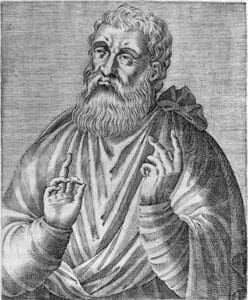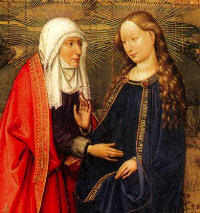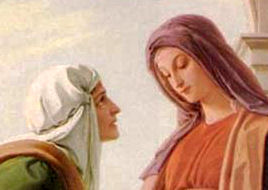St. Justin Martyr’s timeless description of the Mass in the early church
By DAVID A. KING, Ph.D.|Published March 30, 2024
My OCIA elect are preparing for acceptance into full communion with the Church at the Easter Vigil, the week after this issue of The Georgia Bulletin is published. They are all excited about their multiple faith journeys finally uniting as one when they receive the sacraments for the first time.
One of the great joys of working with OCIA is that catechesis constantly reminds me of my own conversion experience, as well as my abiding love for the church. I’ve been a Catholic for well over half my life now, but I still remember the anticipation and gratitude I felt at finally being able to participate fully in the Mass.
When the novelist Walker Percy was asked why in the world someone like him would ever become a Catholic, he said simply, “The reason I am a Catholic is that I believe that what the Catholic Church proposes is true.” So do I. Percy goes on to say “I’d as soon let it go at that and go about my business. … I have not the least desire to engage in an apologetic or a polemic or a ‘defense of the Faith.” I feel the same way.
Not a month goes by that I am not called upon to debate with someone, who is usually well meaning, matters of church teaching. The questions seem to always start the same way: “Where is that in the Bible?” A sly smile often precedes the inquiry, and I know the interrogation will probably become a volley of Bible verses fired from the nooks and crannies of both Old and New Testaments.
As someone raised Baptist, I can hold my own in what we used to call a “Sword Drill,” but I don’t enjoy it. I would rather try to explain that my concept of church is “One, Holy, Catholic, and Apostolic” that depends upon a sound protection of teaching and practices entrusted generation unto generation for more than 2,000 years.
After conversations like these, I often turn to some of the classic apologies for Catholicism. I’ve already mentioned Walker Percy. Of course there is G.K. Chesterton. My favorites include Romano Guardini on the liturgy, Flannery O’Connor’s wonderful letters, and Thomas Merton’s contemplations and conjectures. Long before these moderns, there was St. Justin Martyr, whose description of the Mass in the early Church circa 155 A.D. is a timeless monument to the beauty and truth of Catholic tradition and apostolic teaching.
A defender and explainer
St. Justin was born in Samaria, to a Greek family, circa 100 A.D. He converted to Christianity at Ephesus, in about 130, and was martyred by beheading in the year 165. One of the great early church fathers, he was an important defender and explainer of the faith in the still pagan Roman Empire. Among his few writings that have not been lost, we have two Apologies and a Dialogue.
St. Justin had a zeal for education, and in his early years he sought out many teachers, most of whom failed to convince him. A seeker, he had like all of us an innate desire to know God. Legend has it that Justin met an elderly Christian man on the beach who evangelized him by telling him about the importance of the Prophets. As he studied further, Justin became enamored of both Christianity’s aesthetic qualities as well as its basis in Hebrew history and prophecy.

St. Justin Martyr, who wrote the First Apology, is depicted in this work by Andre Thevet. Wikimedia Commons, public domain
Following his conversion, Justin began to formulate a philosophy of Christianity that placed the Word of God, Logos, at its center. Justin argued that Logos, along with the working of the Holy Spirit, was responsible for a type of proto or pre-Christianity, in which the great prophets and philosophers had intimations of Christ before he became incarnate. Like St. John, Justin believed that indeed the “Word became flesh and dwelt among us.”
Further, like St. Thomas Aquinas many centuries later, Justin argued that faith required both belief and intellect. A person could have an innocent and sincere faith yet support that hope through philosophical reasoning.
St. Justin’s work is refreshing because it is so fundamentally sound and clear. These qualities are certainly apparent in his famous description of the Celebration of the Eucharist in the early church. In the passage, which appears in the First Apology dedicated to Roman Emperor Antoninus Pius, Justin explains what we do at Mass, how we do it and why we do it. He reveals the Mass as essentially unchanged, and reminds us that it is liturgical, memorial and sacrificial. He underscores the Real Presence: “the food that our flesh and blood assimilates for its nourishment becomes the flesh and blood of the incarnate Jesus by the power of his own words contained in the prayer of thanksgiving.”
The description of Mass is only about 500 words long, but it references nearly all the components of the liturgy we celebrate today. It never fails to startle me every time I read it, and it remains one of the most memorable teaching aids on what Catholics profess to believe about the Eucharist. It exemplifies the importance of tradition, both in terms of how we hand one another along and how we safeguard our history and affirm its relevance to the present time.
St. Justin covers the essence of Lawful Reception: “No one may share the Eucharist with us unless he believes that what we teach is true, unless he is washed in the regenerating waters of baptism for the remission of his sins, and unless he lives in accordance with the principles given us by Christ.” He reminds us that “We do not consume the Eucharistic bread and wine as if it were ordinary food and drink.” He references the Gospels, “the recollections of the Apostles,” and affirms what they teach about the institution of the Eucharist at the Last Supper.” He says of this teaching that “The Lord gave this commandment to them and ever since then we have constantly reminded one another of these things.” He affirms the Trinity, writing that all we receive comes through the “Creator of the universe through his Son Jesus Christ and through the Holy Spirit.”
Justin considers equality and community essential to the Eucharistic liturgy: “The rich among us help the poor and we are always united.” He describes Christians as meeting in “common assembly.”
What today we call the Liturgy of the Word was clearly a component of St. Justin’s Mass. There was a prophetic reading, and a reading of the Gospels. There were communal prayers. I chuckle that Justin was mindful of the congregation’s attention span. What we might think of as a homily is given “as long as there is time.”
The Liturgy of the Eucharist, though not described in detail, closely adheres to current practice, and includes an offertory, presentation of gifts and a eucharistic prayer. There is even a collective Amen. Justin notes that when the Eucharist is distributed “everyone present communicates, and the deacons take it to those who are absent.”
Justin, who himself was likely a deacon, describes how those who are able make a monetary donation that is used to “help the orphans and widows and all who for any reason are in distress, whether because they are sick, in prison, or away from home. In a word, he takes care of all who are in need.”
How early Christians lived
St. Justin’s recollection is almost a miniature catechism. If I were not already Catholic, and I read this ancient description, I would immediately want to know more. St. Justin is describing true Christianity, and not only in terms of worship practices and Sacraments. He affirms that early Christians were living Christ’s message in practical and necessary ways. Most of all, he demonstrates the love that the congregation had for one another.
The description concludes with an explanation as to why the Christians meet on Sunday: “because it is the first day of the week, the day on which God put darkness and chaos to flight and created the world, and because on that same day our savior Jesus Christ rose from the dead.”
Sadly, Christianity today is fragmented and divided. Many people have lost all sense of what Christ meant by church. St. Justin Martyr reminds us, in clear and eloquent prose, of the simple yet great gifts of our Catholic faith.
Justin wrote the First Apology as an answer to questions that the emperor had about Christians and their worship. The description of the Eucharist becomes something more than an explanation, however. It is a testament to the truth we profess, and an invitation to share in the joy of practicing that truth in the enduring Catholic Church. St. Justin, pray for all our elect across the archdiocese as they prepare to enter fully into that mystery.











 The Mother of God considered no such thing. Elizabeth was going to have a child, too, and although Mary's own child was God, she could not forget Elizabeth's need—almost incredible to us, but characteristic of her.
The Mother of God considered no such thing. Elizabeth was going to have a child, too, and although Mary's own child was God, she could not forget Elizabeth's need—almost incredible to us, but characteristic of her.